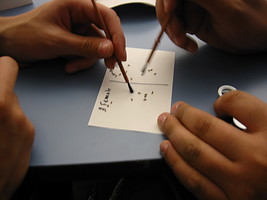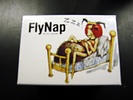Introduction
The purpose of this experiment is to learn about heredity in genetics through the study of fruit flies. The reasoning behind using fruit flies was because fruit flies have fairly obvious mutations, reproduce quickly, have a large number of offspring, and are much easier to work with in a science classroom than some other animals.
Classification
Kingdom: Animalia
Phylum: Arthropoda - exo-skeleton, molting,open circulatory systems, segmented body parts, cephalization
Class: Insecta - antennae, six legs, mandibles, 3 body segments
Order: Diptera -1 pair of wings sucking, lapping, piercing mouth parts
Family: Drosophilidae
Genus: Drosophila
Species: melanogaster
Phenotypes
Wild phenotype - is the normal mutation of a fruit fly with normal wings and normal red eyes
Vestigial phenotype - the wings on this mutation are short and wrinkled.
Recessive sex-linked white phenotype - white eye mutation of a fruit fly.
Group Life Cycle Log
Date Observations
3/16 Not enough flies mating no larvae
3/17 Still not enough flies, no flies have died still no larvae
3/20 Larvae, eggs, 1 dead fly, no pupas
3/21 Lots of larvae, 15 visible, 1 visible egg, no more flies have died, the larvae in varying stages.
3/23 There are lots of pupae and some parent flies and larvae that are ready to become pupae
3/24 With the parents gone, the larvae are living large. The pupae, on the other hand are just lying around, lazy teenagers.
Sexing the Flies
We found it was time to sex flies for the first time. This was a practice run, with no real consequence for failure (later, we had to sex them to properly distribute males and females of the correct type into vials: ( Now THAT was serious!), but it was still gross.
We had to knock them out, so we used a substance called FlyNap.
We inserted an absorbant wand filled with the potion into the vial. The flies were asleep in two minutes.
Once they were FlyNappin', we shook them out onto a card. We then looked at them under a magnifying lens, determined their gender, then we killed them. In rubbing alcohol.
When we did it for real, we followed the same procedure, except that, instead of murdering them, we distributed the correct gender/type combinations into the correct vials. Then came the fly sex. And now we have many happy larvae. Wait... make that many happy flies, a bunch of pupae, and a small scattering of larvae! Go miracles of nature! But soon, too soon, the hatchlings grew, were sexed, and ritualistically murdered. And now we know the truth. Rated R.
F1 predictions
We made predictions about whether the traits would be dominant or recessive. We also made predictions about whether traits were sex-linked or if we switched the dominant and recessive genes about what outcomes would be.
vg=vestigial; vestigial is where the wings are not fully developed, they are usually crinkled or smaller than the normal wings. + = wild; wild is just a normal fly, they have normal wings and red eyes.
| vg | vg | |
| + | vg+ | vg+ |
| + | vg+ | vg+ |
| X+ | Y | |
| Xvg | XvgX+ | XvgY |
| Xvg | XvgX+ | XvgY |
F1 outcomes
| Vial1&2 | vg | vg |
| + | +vg | +vg |
| + | +vg | +vg |
Phenotypes=100% vg
F2 Predictions
| vial1 | + | vg |
| + | ++ | +vg |
| vg | +vg | vgvg |
| Phenotypes Vial1 f2 |
| 75% wild |
| 25% vestigial |
| vial2 | + | vg |
| + | ++ | +vg |
| vg | +vg | vgvg |
| f2 Phenotypes vial 2 |
| 25% homozygous wild |
| 50% heterozygous wild |
| 25% homozygous vestigial |
F2 Outcomes
| overall total | wild females | total + | wild males | vg female | vg male | total vg | |
| vial 1 | 347 | 95 | 295 | 200 | 27 | 25 | 52 |
| vial 2 | 218 | 85 | 168 | 83 | 27 | 24 | 51 |
| vials 1&2 | + | vg |
| + | ++ | +vg |
| vg | +vg | vgvg |
| f2 percentages vial 1 |
| wild=85% |
| vg =15% |
| f2 percentages vial 2 |
| wild=77% |
| vg =23% |
F2 fly counts
| Vial 1 | Overall total | Total Female + | Total Male + | Total Female VG | Total Male VG |
| 347 | 95 | 200 | 27 | 25 | |
| Vial 2 | Overall total | Total Female + | Total Male + | Total Female VG | Total Male VG |
| 218 | 85 | 83 | 27 | 24 |
Observed versus Expected
Phenotype Observed Expected (O-E) (O-E)/E X100 %error
vial 1 - wild 295 260.25 34.75 0.13352 13.35 13.35%
vestigial 52 86.75 -34.75 -0.40057 -40.05 40.05%
vial2 - wild 168 164.25 3.75 0.02283 2.283 2.283%
vestigial 51 54.75 -3.75 -0.06849 -6.849 6.849%
Observed and Expected and the Hypothesis
The wild expected less than observed and the vestigial phenotype expected more than the observed number so that supports the autosomal recessive hypothesis.
Percent error that is too high for the hypothesis:
-40% in vial one phenotype vestigial seems too high for the hypothesis compared to vial two for the same phenotype.
Factors for high percent error:
mishandling vials led to death, and letting flies out of the vial
accuracy- observe more carefully
Conclusion
In conclusion we hypothesized that the phenotypes for the flies would end up at 75% wild type and 25% vestigial for our F2 generation. According to our data and our error percentage we were right, because we only had an error percentage of 2% and 6% on our vial 2 flies which means that we were 98% and 94% correct. In addition to our incredibly accurate results, the data was a bit skewed because not all of the flies accounted for/. For instance flies that died or escaped during the napping process. But the next time we do this we will all be better at the napping process because of all of our experience.
Eulogy for the Flies
Our flies were not human. They were not even vertebrates. But they came as close to our hearts as they could through the walls of a glass tube. They touched our hearts in a way only something that never made physical contact with us could. We loved them like our own children. We put them to sleep, determined their gender with a magnifying lens, then dumped them into rubbing alcohol, killing them instantly. We commit them to the void and such and so forth but nigh time is short. Lunch is in about ten minutes. Amen







 Go to quick links
Go to quick search
Go to navigation for this section of the ToL site
Go to detailed links for the ToL site
Go to quick links
Go to quick search
Go to navigation for this section of the ToL site
Go to detailed links for the ToL site